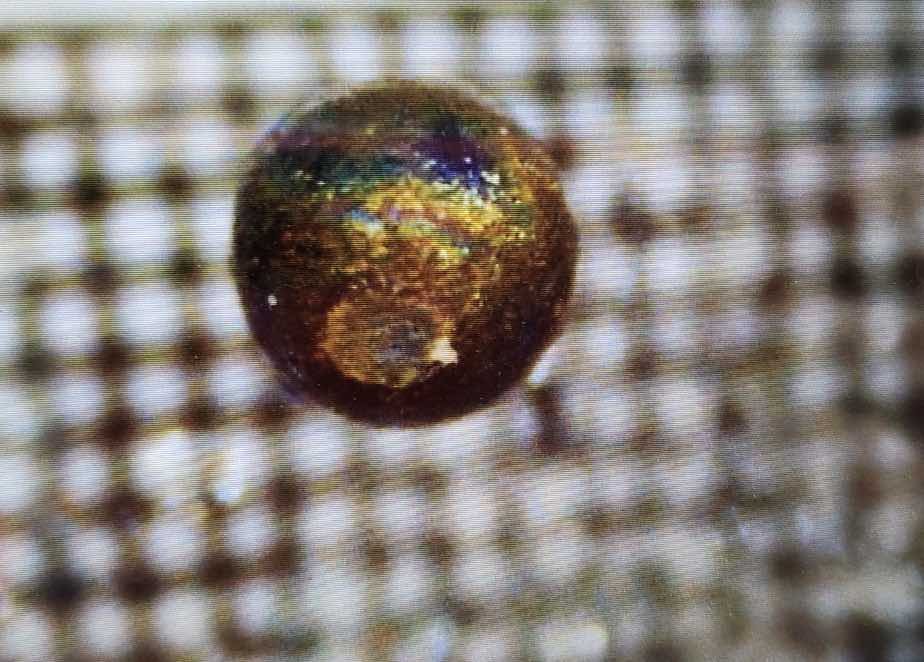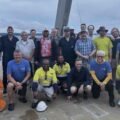Now that we measured the composition of the first recognized interstellar meteor, IM1, can we recreate its material making in the laboratory?
The stress tolerated by IM1 before it disintegrated implies that it was tougher than iron meteorites in the solar system. This raises important questions: What was IM1’s melting temperature, thermal conductivity, material strength, or electric conductivity?
Given the measured over-abundances in beryllium (Be), lanthanum (La), and uranium (U), dubbed “BeLaU,” by factors of hundreds above solar-system rocks, it is intriguing to figure out whether IM1 was natural or technological in origin.
If natural, IM1 could be the product of a planet with a magma ocean and an iron core, where elements with affinity to iron sink towards the core and other elements left behind in the planet’s crust reflect the “BeLaU” abundance pattern discovered in our new scientific paper. Following extensive work and many sleepless nights over the summer, the paper was posted on the arXiv preprint server on August 29, 2023, exactly two months after our return from the expedition.
In an unprecedented gesture, the arXiv administrators chose to highlight the paper with a dedicated video featuring a summary of the paper’s findings, read by artificial intelligence (AI). The arXiv director, Steinn Sigurdsson, emailed me the insight that if IM1 was technological in origin, then the enhanced abundance of heavy elements in “BeLaU”-type spherules could have resulted from the fact that LaO over Mo or W sulfide substrates are promising materials for 2D semiconductors in nanotech fabrication. Of course, everyone knows that U is used in fission reactors.


Gladly, there is more to be learned from further analysis. Radioactive isotopes in the “BeLaU”-type spherules can be used as clocks based on their known half-life and the relative abundance of daughter and parent nuclei. The brilliant Stephen Wolfram emailed me a list of a wide range of useful isotopes with a relevant half-life for measuring the duration of interstellar journeys, including plutonium-244 with 81 million years, uranium-235 with 0.7 billion years, potassium-40 with 1.25 billion years, uranium-238 with 4.46 billion years – similar to the age of the solar system, and thorium-232 with 14 billion years – similar to the age of the universe. Unfortunately, the decay product of uranium, lead (Pb), is volatile and was lost by evaporation in the fiery IM1 fireball at temperatures of thousands of degrees.
Dimitar Sasselov pointed out to me that another method to estimate the duration of the interstellar journey is from the abundance of beryllium, which accumulates over time as a result of spallation by interstellar cosmic rays. Looking up during a starry night on the deck of the expedition ship, M/V Silver Star, it occurred to me that measuring the duration of IM1’s journey and multiplying it by its known velocity outside the solar system could inform us of the distance and direction of its source star. This provides a unique opportunity to identify the postal address of IM1’s sender.
But can we figure out what the material making of IM1’s package that landed at our doorstep?
A recipe book for cakes includes a list of ingredients and their relative contributions to the mix. We have this list of constituents for IM1, short of volatile elements that were lost by evaporation during the meteor’s fireball. Can we add the missing ingredients with a reasonable measure, mix the elements and check what “cake” we get for IM1?
While it may be pricey to mix all relevant elements in a laboratory, AI offers another path forward. We could simulate the “cake” by mixing the ingredients and measuring the properties of the composite alloy on the computer. Before my morning jog at sunrise, I emailed a professor at Harvard’s department of Material Science & Mechanical Engineering, who developed an AI code to simulate the properties of alloys. My ask was for him to simulate the composition of IM1 and calculate the properties of the product.
A simpler way to reconstruct IM1 is by finding a big piece of it lying on the ocean floor. The fireball heat may have eroded just the surface of IM1, leaving core components from it on the ocean floor. To find them, we are planning a future expedition with sonar imaging equipment that could differentiate between IM1’s fragments and terrestrial rocks. Now that we mapped where the excess IM1 spherules were located relative to the background material in the control regions that we surveyed, we can forecast where large pieces could have landed based on their size. The friction force exerted by air scales with area, whereas the gravitational force scales with volume so that smaller objects slow down faster because of their larger area-to-volume ratio. Just as with raindrops, the terminal speed depends on the balance of the two forces and increases with size. All of this can be factored in to forecast the expected location of larger IM1 pieces, depending on their sizes.
The task is challenging but the rewards are inspiring. To paraphrase on John F. Kennedy speech at Rice University about the space effort during my birth year of 1962: “We choose to go to the Pacific Ocean this year and do the other things, not because they are easy, but because they are hard, because that goal will serve to organize and measure the best of our energies and skills, because that challenge is one that we are willing to accept, one we are unwilling to postpone, and one which we intend to win.”
The “BeLaU” composition pattern of IM1’s spherules had never been reported before in the scientific literature and was not found in our control regions – where the recovered spherules had solar system composition. Most of my career focused on theoretical physics, predicting what the universe should look like. This summer I chose to lead an experimental project. This interstellar expedition convinced me of the words of Yogi Berra: “In theory there is no difference between theory and practice. In practice there is.”
Avi Loeb is the head of the Galileo Project, founding director of Harvard University’s – Black Hole Initiative, director of the Institute for Theory and Computation at the Harvard-Smithsonian Center for Astrophysics, and the former chair of the astronomy department at Harvard University (2011-2020). He chairs the advisory board for the Breakthrough Starshot project, and is a former member of the President’s Council of Advisors onScience and Technology and a former chair of the Board on Physics and Astronomy of the National Academies. He is the bestselling author of “Extraterrestrial: The First Sign of Intelligent Life Beyond Earth” and a co-author of the textbook “Life in the Cosmos”, both published in 2021. His new book, titled “Interstellar”, is scheduled for publication in August 2023.

